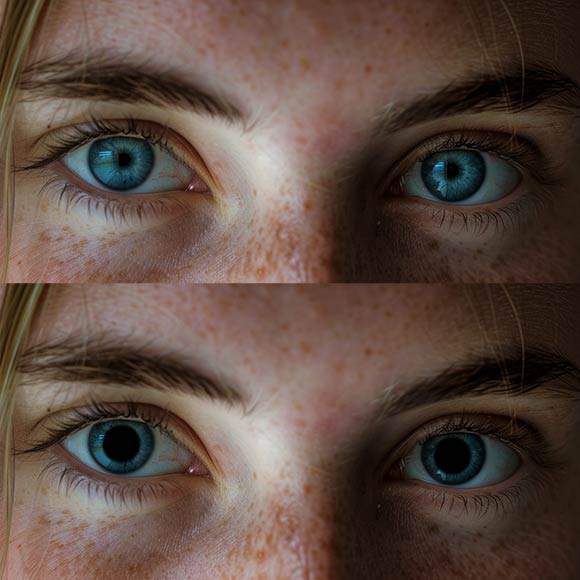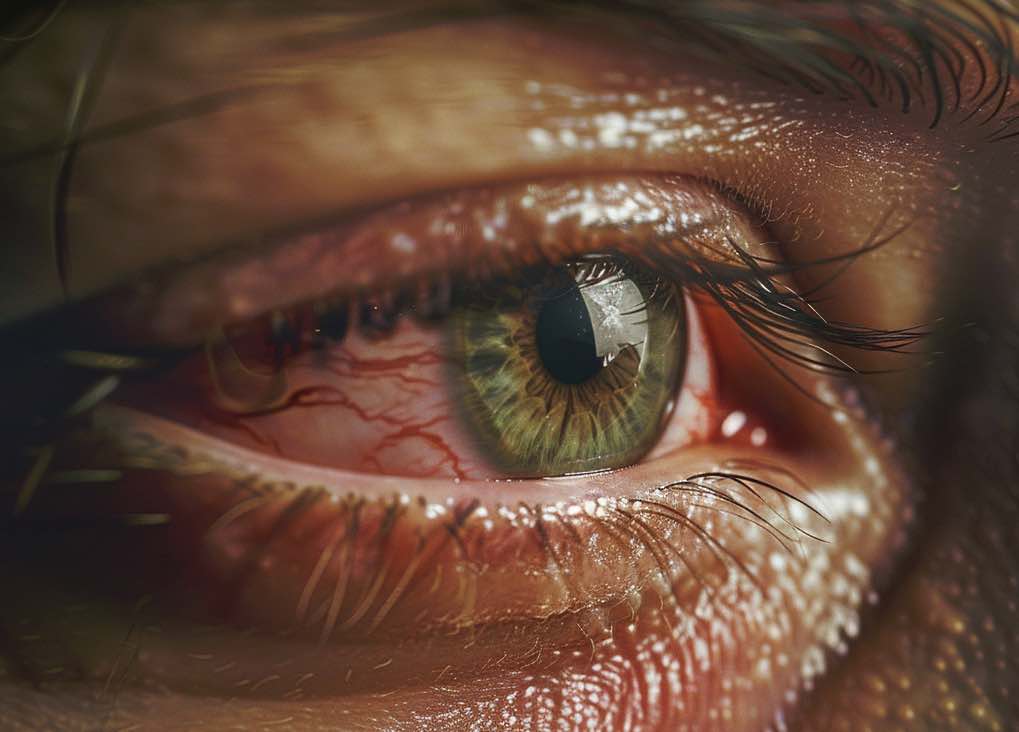Eyes are the telltale sign of someone abusing drugs; that’s why they’re called high eyes. Substance abuse impacts your pupils and overall vision in ways you may not realize. All of the substances have different effects on the eyes, and many of these symptoms are the first step toward a much worse condition if someone continues to abuse these drugs.
Table: How Drugs Affect Your Pupils and Vision
| Eye Condition | Associated Drugs |
|---|---|
| Dilated Pupils | Stimulants like cocaine, MDMA (ecstasy), LSD (acid) |
| Constricted Pupils | Opioids like heroin, oxycodone, and hydrocodone |
| Blurred or Double Vision | Alcohol, marijuana, opioids, benzodiazepines (like Xanax) |
| Light Sensitivity | Stimulants like cocaine, MDMA, psychedelics like LSD |
Dilated or Constricted Pupils
When under the influence of drugs, your pupils may become dilated (enlarged) or constricted (small). Dilated pupils occur with stimulants like cocaine, MDMA (ecstasy), and LSD (acid), while constricted pupils happen with opioids like heroin, oxycodone, and hydrocodone. An abnormal pupil size could indicate drug intoxication and may lead to visual problems.
Blurred or Double Vision
Many drugs can cause blurred or double vision, including alcohol, marijuana, opioids, and benzodiazepines (like Xanax). Blurred vision occurs when the eyes have trouble focusing, while double vision is seeing two images of a single object. Either condition can impair your ability to read, drive, and perform detailed tasks. The effects are often temporary but may become permanent with long-term drug abuse.
Light Sensitivity
Some drugs make your eyes overly sensitive to light (photophobia). Stimulants like cocaine and MDMA are common causes, as are psychedelics like LSD. Looking at bright lights may be painful and uncomfortable.
Dilated Pupils: The Eyes Have It With Meth, MDMA, and Cocaine
Methamphetamine
Methamphetamine causes the pupils to dilate. As meth enters the bloodstream and crosses the blood-brain barrier, it activates the sympathetic nervous system.
According to research by The National Library of Medicine;
Methamphetamine increases the production of dopamine in the brain and activates reward centres of the brain giving a sense of euphoria soon after taking the drug and causes aggressiveness, anxiety and dilated pupils. It is known to cause crystalline retinopathy by intranasal methamphetamine use. Pupil size can increase by up to 60% of their normal size. These enlarged pupils make the eyes appear dark and glassy and do not react to light changes. Pupil dilation from meth use typically lasts 3 to 8 hours but can persist for up to 24 hours.
MDMA (Ecstasy)
MDMA, known as ecstasy or molly causes the release of serotonin, dopamine, and norepinephrine in the brain, which leads to pupil dilation. Pupils may increase in size by 30 to 60% and will become sensitive to light. The effects of MDMA on pupil dilation, generally last 3 to 6 hours, but in high doses, they can last up to 24 hours.
Cocaine High Eyes
Cocaine blocks the reuptake of dopamine, serotonin, and norepinephrine in the brain, leading to an accumulation of these neurotransmitters. Pupil size may increase by up to 60% and remain dilated for the duration of the cocaine high, which is typically 30 minutes to 2 hours. However, the effects of cocaine on the pupils and the body can last for several hours after the initial rush.
Pinpoint Pupils: Opioids Constrict Your Pupils
Pupil constriction, or pinpoint pupils, is one of the primary signs of opioid use and an opioid high. When opioids enter the bloodstream and cross the blood-brain barrier, they begin to take effect on the body and brain. One of the first physical signs is constricted pupils. Opioids activate the parasympathetic nervous system, which is responsible for the body’s rest and digestion functions. This system also controls pupil size, and opioid use causes the pupils to constrict into pinpoints.
How Pinpoint Pupils Develop
The pupils, the black circles in the center of your eyes, constrict or dilate based on the amount of light that enters your eyes. When it’s dark, your pupils dilate to let more light in. When it’s bright, your pupils constrict to limit light exposure. Opioids artificially activate this pupillary light reflex, causing the pupils to constrict even in normal or low-light conditions.
The pupils can constrict to pinpoints within minutes of opioid use and remain constricted for hours. As the effects of the opioid begin to wear off, pupil size will gradually return to normal. However, repeated use or high doses of opioids can cause pupils to remain constricted for longer periods.
Alcohol Eyes: Booze Impairs Vision in Many Ways
Alcohol consumption can have a detrimental impact on your eyesight and visual perception in several ways. When you drink alcohol, it is absorbed into your bloodstream and dispersed throughout your body, including to your eyes. This can impair their ability to function properly and focus accurately.
Pupil Dilation
After drinking alcohol, your pupils become dilated, allowing more light to enter your eyes. This impairs their ability to focus and makes bright lights seem harsh and glaring. Pupil dilation also makes it difficult for your eyes to adjust between light and dark environments. The dilation effect typically lasts for several hours after your blood alcohol content returns to zero.
Depth Perception
Alcohol affects the muscles that control eye movement and convergence, impairing depth perception. This makes it difficult to determine distances between objects and judge the relative speeds of moving objects. This particular lack of depth perception and impaired eye coordination is one of the main reasons behind car accidents and injuries after drinking.
Double Vision, Blurry Vision
Double vision, also known as “diplopia,” happens when the eyes have trouble working together to focus on a single image. The eyes become uncoordinated, and you perceive two separate images of the same object. Diplopia typically disappears once the effects of alcohol wear off and your blood alcohol content returns to zero. This condition can be an indicator of a nerve or muscle damage in some cases when alcohol is abused for a longer period of time.
According to All About Vision;
Blurred vision typically occurs at 0.10% blood alcohol level. The number of drinks it takes to get to that level varies based on sex, weight and other factors. For example, it may only take two drinks in an hour for a 100-pound woman to experience blurred vision or up to five drinks in an hour for a 240-pound man.
Dry Eyes
Alcohol is a diuretic, meaning it causes dehydration throughout your body, including your eyes. This causes a lack of lubrication which leads to dry, irritated eyes. This condition causes stinging, burning, and redness.
Marijuana High Eyes: Red Eyes, Stoner Eyes
One of the most noticeable effects that occurs shortly after smoking marijuana is red eyes. THC (tetrahydrocannabinol) in marijuana lowers blood pressure, which dilates the blood vessels and increases blood flow throughout the body. This causes the blood vessels in the eyes to expand, causing redness or bloodshot eyes.
Long-Term Effects of Substance Abuse on the Eyes
Pupil Changes
Long-term substance abuse can lead to changes in pupil size and reactivity. When drugs like opioids, amphetamines, and cocaine are abused repeatedly, it results in uneven or abnormal pupil sizes, known as anisocoria. The pupils may also demonstrate sluggish reactivity to light, or pupillary unrest, where the pupils rapidly change size. These symptoms indicate damage to the nerves controlling the pupils.
Vision Impairment
Chronic substance abuse is associated with vision changes and impairment. Drugs like alcohol, opioids, and stimulants can cause blurred vision, double vision or tunnel vision. Marijuana use is linked to decreased night vision. Long-term usage of any of these substances poses risks like optic neuritis (inflammation of the optic nerve), retinal hemorrhages (bleeding in the retina), and cortical visual impairment (damage to the visual processing areas of the brain). There is a danger that these vision problems may persist even after discontinuing drug use.
Eye Muscle Problems
Nystagmus is a condition where the eyes make repetitive, uncontrolled movements, which can cause reduced visual acuity and depth perception. Strabismus or crossed eyes can also develop. These conditions may be temporary during intoxication but can become permanent if someone continues to abuse these drug use.
According to EyeWiki;
Nystagmus can happen with various drugs, including phencyclidine (PCP), anticonvulsants (such as phenytoin, carbamazepine, valproic acid, lamotrigine, and topiramate), ethanol, amphetamines, barbiturates, benzodiazepines, 3,4-Methylenedioxymethamphetamine (MDMA or ecstasy), salicylates, selective serotonin reuptake inhibitors (SSRI), lithium, dextromethorphan, ketamine, lysergic acid diethylamide (LSD) and morphine. These substances may be associated with various types of nystagmus, including vertical, horizontal, rotatory, or mixed nystagmus.
In summary;
Drugs that cause increases in serotonin levels (cocaine, LSD, MDMA) cause dilation. Serotonin stimulates the 5-HT2A receptor. It has an inhibitory effect on areas of your visual cortex.
Some drugs increase norepinephrine levels, including cocaine and meth. This stimulates the sympathetic nervous system, causing the “fight or flight” response. One of these responses is the dilation of the pupils. This uses the iris dilator muscle, which does the opposite of the sphincter muscle and pushes the iris open.
Glassy eyes are caused by the eyes drying out and pupil dilation. This condition is caused by drugs that depress the central nervous system. One reason this happens is that you blink less if your nervous system gets turned down. This appearance is exacerbated by pupil dilation.
Opioid use causes the pupils to constrict into pinpoints.
Red eyes are caused by blood vessel expansion. Dilation is caused either by the brain shutting down the constriction muscles or by turning on the dilation muscles, depending. Constriction is caused by the brain activating the constriction muscles.
Still Detox Drug and Alcohol Rehab in Boca Raton, Florida
It is never too late to get help if you or someone you care about struggles with substance misuse or addiction. Our teams of trained physicians, healthcare professionals, counselors, and more can help you recover from addiction, and sustained recovery can improve your overall health, including your vision. Call now to get help; (561) 556-2677









